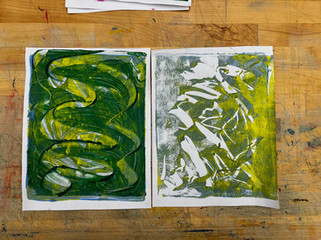Printmaking
- Makalla Shernick

- Nov 25, 2022
- 3 min read
Adjectives
Slow, permanent, methodical, original, spontaneous, fluid
Supporting materials
Printmaking materials vary depending on the type of printing
Ink or acrylic paint
Brayers
Carving tools
Linoleum
Gelli Plates
Hot press watercolor paper or Bristol
Solvents
Gloves
Paper towels
Brushes
Plastic palette knives
Access to a sink with soap and water

Safety & Health Considerations
Carry out in well ventilated area
Wash hands before ink dries
Goggles, gloves, aprons
Tie back loose hair
AAA-Always Add Acid to water
Do not run an electric press with wet hands
Use EZ cut plates
Add water to acid, causes splashing
Do not inhale, spill, or drink solvents
Accommodation Possibilities
Stations can be used to simultaneously teach students about multiple forms of printmaking while also allowing for students to choose a form of printmaking that is best suited for their interests/abilities.
Appropriate Age Group & Behavioral Expectations
K-5 students will be able to safely use and maintain materials. They will be able to experiment creatively with various forms of printmaking. Students will be able to create prints that do not require the use of sharp (potentially dangerous) materials or solvents. They will be able to articulate how printmaking relates to the world around them.
6-12 students will be able to use sharp tools and solvents correctly and safely. They will be able to understand and demonstrate the ability to make relief, intaglio, and planar printing processes. They will also have a more developed understanding of the role of printmaking in art and history.
Brands and Associated Quality/Cost
Gelli Plate: A Gelli plate is an easy and safe method of mono-printing. The plates are reusable and easy to clean.
Brayers: Brayers are essential for printing because they allow for an even distribution of ink across a surface.
$ Blickrylic: This acrylic paint is great for students due to its economical price point. They offer a wide variety of colors that include floresents and metallics.
$$ Liquitex Heavy Body Acrylics: These heavy body acrylics are used widely by professional artists. They have a high pigment load that produces a rich, brilliant, permanent color and with good surface drag. It also has an increased working time than softer body acrylics.
Artist Resource & Project idea
Elizabeth Peyton is a contemporary American artist who works primarily in painting, drawing, and printmaking. She is best known for her small-scale portraits of celebrities, friends, and historical figures.
My project idea is to have students use Gelli plates to create original monotype prints. I was able to try out this project in the 2022 Fall semester of MCAA's Saturday Art classes with students aged 11 to 16. The conceptual basis for this project was inspired by the relationship between printmaking and language.
This is an image from the student's showcase of this project.

Studio Engagement
This is my exploration of monotype printmaking. One type used shaving cream and food coloring and the other being acrylic paint and Gelli plates.
Portals and Pathways
My research-based artistic exploration revolves around the theme Portals and Pathways. For this printmaking activity, I used a linoleum rectangle and a carving tool to create a relief print design. It was around Halloween time when I was creating the design for this print, and I leaned more into the fantasy depictions of portals. The multiplicity nature of printmaking enhanced the overall affect and idea of multidimensional portals. I started by drawing on my design and filling in the areas darker that I would want to take away. After cutting my design, I used a brayer and paint to cover the surface of the print. The easiest way I found to make the print was by pressing the paper on top of the linoleum, as opposed to using it as a stamp.
Here is my process of creating a linoleum print.
Here are the prints I made—9 in total.
























Comments